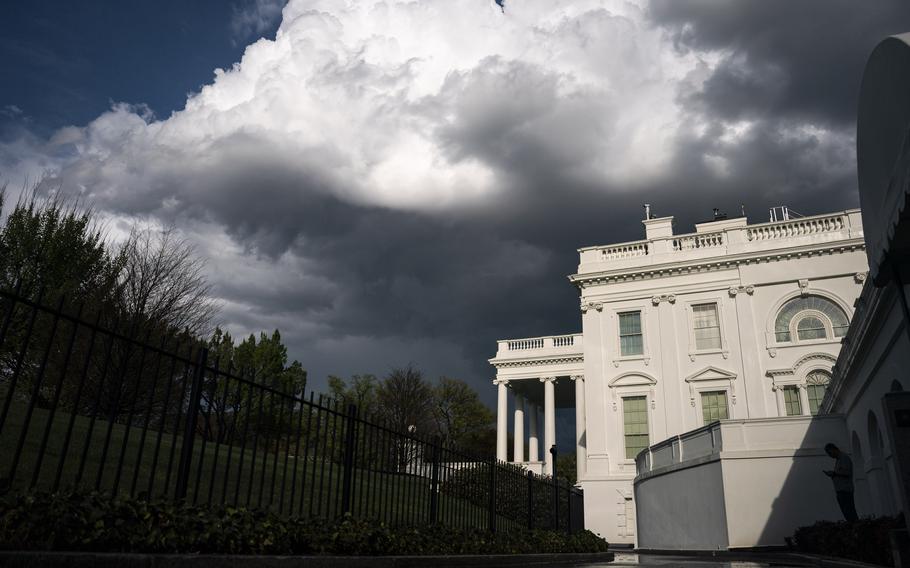
The sun sets at the White House on March 31, 2025. (Jabin Botsford/The Washington Post)
The 2024 election victory of President Donald Trump by a majority of the Electoral College votes and a narrow plurality of votes cast at the polls understandably has been a source of great political satisfaction for his partisan base, and for his now captive Republican Party.
The committed core of the president’s fervent support has experienced nothing short of jubilation, given the highly confrontational and contentious approach of this leader, especially on social and affirmative action, and immigration issues. The fiscal restraint of traditional Republicanism is another matter, given the spending and deficit escalations that are now characteristic of Trump.
In this atmosphere, Americans generally, and especially Trump supporters, should reflect thoughtfully on our history, and specifically on the very serious problems that have afflicted nearly all presidents fortunate enough to have a second term in the White House.
Barack Obama was vexed by IRS targeting of conservative groups, George W. Bush by the Iraq insurgency, Bill Clinton by impeachment, Ronald Reagan by the Iran-Contra scandal, and Lyndon B. Johnson and Harry S. Truman by wars — in Vietnam and Korea — that forced early retirement of the former. Richard Nixon was driven from office.
Even Franklin D. Roosevelt suffered major difficulties. He is viewed as a great president and great politician, given his unique accomplishment of successive election to the White House four times. Yet FDR in his second term was frustrated by Supreme Court vetoes of New Deal reforms, and attempted to expand or “pack” the nation’s highest judicial body.
Dominant Democrats in Congress were more sensitive to the constitutional bulwark of separation of powers than to even a very powerful chief executive of their own party, and Roosevelt rightly was rebuffed. His vainglorious effort to change our institutional balance in such a fundamental manner stands as a major mistake of his tenure.
The single exception among relatively recent presidents to second term setbacks is Dwight D. Eisenhower, whose historical reputation has steadily risen since he left office in 1961. Professor Fred Greenstein of Princeton University, an influential and unusually perceptive political scientist among the Eisenhower revisionists, argues that this “hidden-hand” president exercised deft executive leadership while largely avoiding direct confrontations.
The sunny good humor Ike almost invariably displayed in public masked an extremely disciplined, thorough style of administrative work. Those who worked for him express respect and admiration, but also almost uniformly testify to his exceptionally disciplined, demanding and at times cold-blooded style of work. You absolutely had to be well-informed and effective in your own job, or you would soon be sidelined or gone.
Eisenhower’s executive skills were honed through long years of difficult staff work, including service for the generally impossible Gen. Douglas MacArthur, and the extraordinary challenges of leading the Allied military coalition in the European theater in World War II. Even very successful American politicians are often surprisingly lacking in true executive experience, discipline and skill.
Managing the Pentagon represented a special challenge. Defense spending consumed more than half the federal budget. Our experience with a large peacetime military was still relatively new.
He responded by placing an overall ceiling on the Pentagon. Services competed intensely among themselves for resources, indirectly protecting the president.
Ike the exception was ever mindful of unanticipated developments and consequences. After his inauguration he promptly ended the Korean War, maneuvered through crises over Taiwan as well as Berlin that were loaded with nuclear danger, and ruthlessly executed covert operations in Nicaragua and elsewhere that were important to keeping the peace of that high-risk Cold War era.
He purchased credit with the public through federal spending restraint.
Having achieved our highest military rank, after achieving our highest political office he scrupulously avoided swagger, chose his public words very carefully and always wore civilian clothes.
Arthur I. Cyr is the author of “After the Cold War — American Foreign Policy, Europe and Asia.”